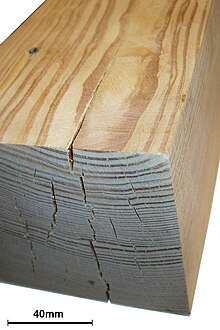Dry cracks (wood)
Dry cracks in the wood occur during storage due to the shrinkage of the wood.
description
As wood dries from the outside in, the sapwood shrinks around the still moist heartwood area and becomes cracked. The heartwood also cracks as it dries. Dry cracks appear as surface cracks on the longitudinal surfaces and brain cracks on the front surfaces . Wood works, absorbs moisture from the ambient air and releases it, which leads to a change in volume . The formation increases particularly with direct exposure to the weather and strong changes in humidity . The wood cells contract more in the tangential direction than in the radial direction. Different shrinkage and swelling behavior leads to the formation of dry cracks in the corresponding grain direction of the wood. The wood works 1.5 to 2 times faster along the annual rings than in the vertical direction, which is why dry cracks always run in a radial direction. When building with wood , care must be taken that it does not dry too quickly and that it is not installed too wet. Cracks can have a negative effect on the load-bearing capacity of the built-up material, and it also offers the roebuck the best conditions for laying eggs .
Reduce drying cracks
Applying a protective varnish to the upper layers of the wood minimizes the exchange of moisture and thus the heavy use. Suitable wood, with the right wood moisture content , should be selected for the respective destination, so it only works in the area of climate change . Avoiding dark surfaces is also recommended , as these heat up strongly and allow the wood to dry out quickly on the outside. Flat surfaces on which water can collect should be avoided.
Logs
Felled tree trunks dry mainly over the cut surface of the front side (end grain ). The larger the diameter of a tree trunk, the more likely it is to develop “cracks in the brain” that can continue deep into the trunk. Heavily cracked tree trunks lose their value and can only be used to a limited extent ( firewood ). In the case of valuable wood , S- or double-T-shaped staples are often struck into the end grain immediately after felling in order to minimize the cracking of these tree trunks.
literature
- Helmuth Neuhaus: Timber engineering. 2nd Edition. Vieweg + Teubner Verlag, Wiesbaden 2009, ISBN 978-3-519-15248-4 .
- Josef Grossmann: Woodworking commercial customer. Wood as a raw material, Springer Fachmedien, Wiesbaden 1922.
- Michael Stahr, Jürgen Weber, Hilmar Kolbmüller, Friedhelm Hensen, Uwe Wild: Building renovation. Detecting and repairing structural damage, 5th edition, Vieweg + Teubner Verlag, Wiesbaden 2011, ISBN 978-3-8348-1406-7 .
See also
- Shrinkage crack (construction)
- Shrinkage (wood)
Web links
- Wood issues
- Cracks caused by drying in Holz Gesamtverband Deutscher Holzhandel e. V.
- Drying-related cracks in wood in outdoor use (accessed on August 9, 2018)
- Cracks in solid wood decking and solid plank coverings in weathered outdoor use (accessed on August 9, 2018)
- The shrinking and cracking of wood (accessed August 9, 2018)
